The Complexity Of Nonuniform Random Number Generation Pdf Converter
The results highlight the significant differences between the three main approaches to random number generation: One is work producing, one is work consuming, and the other is potentially dissipation neutral. TRNGs can both generate random numbers and convert thermal energy to stored work. Nov 23, 2011. In this paper, we present a refined version of the floating point-based nonuniform random number generator already shown at ReConFig 2010 [1]. The modifications allow a. How floating point representation can help to reduce hardware complexity is explained in Section 4. Section 5 shows detailed. Also, the methods for generating random vectors and processes as well as. The most direct way to convert uniform into non-uniform random variables is. By the celebrated Box-Muller transformation, described in §4.6. Example 4.8 (Weibull distribution). The Weibull distribution generalizes the exponential.
I am not sure if any language(preferably C# .NET) supports non-uniform random number generator. Is there any? I was wondering what could be the best design approach to implement our own non-uniform random number generator?
Thanks.
skaffman2 Answers
Well, it’s 2016, this question has no points, and already has an accepted answer. But since, it came up second when I googled “c# random non uniform”, I’ll go ahead and give my approach.
Before starting, you have to consider what kind of non-uniform distribution you want. In my case, I needed most numbers to be low, while a few should be high. For any distribution, we need only consider numbers between 0 and 1 (so properties outside that range are irrelevant). The result can be multiplied or otherwise manipulated to fit any desired range. In the end, (x-1)^4 worked for me. It has a value of 1 when x = 0, a value of 0 when x = 1, but is on average more likely to be low than high.
In C#, the generator of the Random class only produces integers. So the first step is to convert it so that it instead produces a rational number between 0 and 1.
Then, simply plug the random number into the distribution you desired.
I created a list of randomly generated numbers with this method and got the following result (sorted and rounded): Isotek ultimate system setup discussions.
As you can see, the distribution is not uniform: it has a bias toward 0, but can still take on exactly 0 or 1 as a value.
Because of the implications when searching for answers on SO, I’m answering the question as asked. But in @applefreak's comments to his own question, it seems that he may also/instead be looking for a truly, non-pseudo-random number generator. @JonHanna’s response that “that can’t quite be done” is then appropriate. Using a source external to the computer may eliminate the dependency on the time-clock, but it still won't be truly random. You could argue that nothing truly is, but that's a question of philosophy.
pwilcoxpwilcoxI was able to created semi non uniform distribution using uniform distribution for my requirements. Basically I generate the required M numbers from 1 to N range and then again just generate (N-M) numbers and throw them away. Like this way when I generate next set of numbers, I get almost equal probability for all numbers between 1 to N. It worked for me!
Example code in C#:
applefreak
 applefreak
applefreak